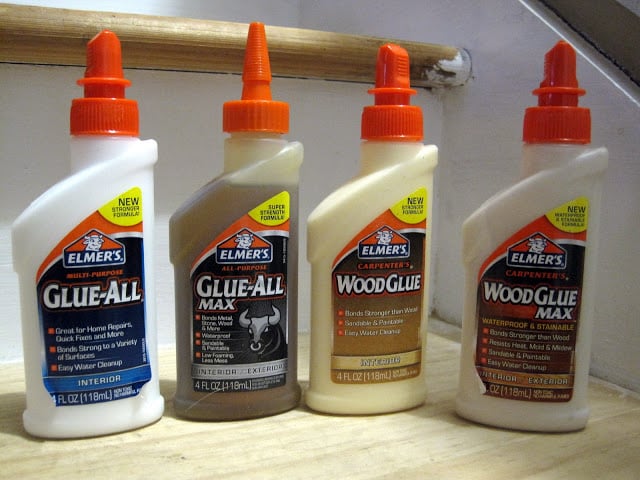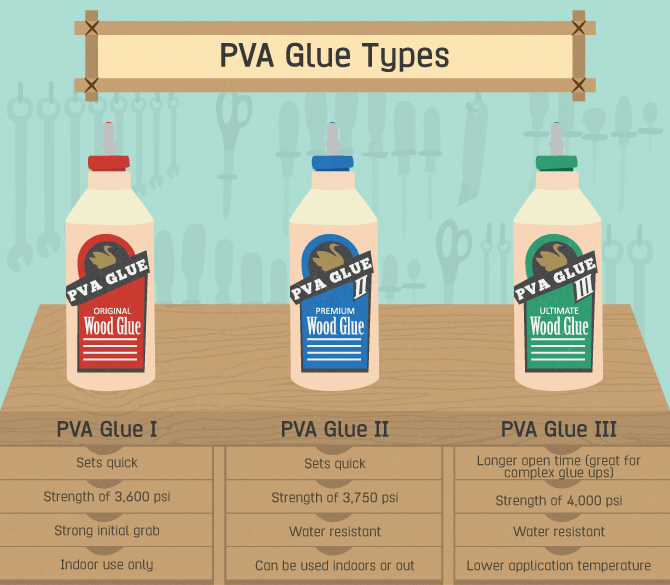Wood glue is stronger and more durable for woodworking projects, while white glue is better suited for general crafts and paper projects. Wood glue forms a stronger bond and is water-resistant, making it ideal for heavy-duty applications such as furniture making.
On the other hand, white glue is versatile and dries clear, making it perfect for school projects and lightweight crafts. Understanding the differences between wood glue and white glue will help you choose the right adhesive for your specific project needs.
Whether you are working on a DIY woodworking project or a fun arts and crafts activity, selecting the appropriate glue will ensure a successful outcome.

Introduction To Wood Glue And White Glue
Wood glue and white glue are two commonly used adhesives in woodworking. Wood glue is typically made from animal hide and bone, while white glue is made from synthetic materials like polyvinyl acetate (PVA).
Both adhesives have key components that make them effective in different ways. Wood glue has a higher bonding strength, making it ideal for woodworking projects that require a strong and durable hold. White glue, on the other hand, dries clear and is more versatile in its application.
| Wood Glue | White Glue |
|---|---|
| Commonly used for woodworking projects | Commonly used for crafts and household repairs |
| Requires pressure to ensure a strong bond | Dries clear, making it ideal for visible areas |
| Water-resistant when dry | Not water-resistant when dry |
When deciding which adhesive to use, consider the specific needs of your project. If you need a strong and durable bond, wood glue is the better choice. If you need an adhesive that dries clear and is more versatile in its application, white glue is the better choice.
Chemical Composition And Properties
Comparing wood glue and white glue: Wood glue contains a higher ratio of resin, making it stronger for woodworking projects. White glue, also known as PVA glue, is versatile and dries clear, perfect for crafts and general household use. Choose based on your project needs.
| Chemical Composition and Properties | |
| Bonding mechanisms | Wood glue typically contains polyvinyl acetate (PVA), which forms a strong adhesive bond when it dries. In contrast, white glue is made of polyvinyl acetate emulsion, and it creates a reliable bond as it cures. |
| Durability factors | Wood glue is waterproof, making it ideal for outdoor projects, while white glue is best suited for indoor use. Consider the exposure and moisture levels when choosing between the two. |
Pros And Cons Of Wood Glue
Wood glue is known for its superior bonding strength, making it ideal for heavy-duty woodworking projects. It dries clear and is stainable, providing a seamless finish. Moreover, it is water-resistant, ensuring durability. On the other hand, white glue is easy to clean and non-toxic, making it suitable for DIY projects with children. However, it may not offer the same long-term durability as wood glue. Additionally, wood glue may require clamping for a certain period, while white glue can be used without this step. Both have their advantages and disadvantages, so choosing the right one depends on the specific project and its requirements.
Wood glue can be messy and difficult to remove once dried, while white glue may not provide the same strength for heavy-duty applications. Moreover, white glue may not be ideal for outdoor projects due to its limited water resistance. Understanding the limitations of each type of glue is crucial for selecting the most suitable option for a woodworking project.

Pros And Cons Of White Glue
White glue, also known as PVA glue, is versatile and easy to use for woodworking projects. It dries clear and is easily sandable. However, it has less bonding strength compared to wood glue, making it less suitable for heavy-duty woodworking applications.
Wood glue and white glue are commonly used adhesives in various woodworking projects. White glue, also known as PVA glue, has several advantages and disadvantages. On the positive side, white glue is versatile and can be used on a wide range of materials, including wood, paper, fabric, and more. It dries clear, making it ideal for projects where appearance is important. Additionally, white glue is non-toxic and easy to clean up with water. However, there are a few drawbacks to using white glue. One disadvantage is its longer drying time compared to other types of adhesives. This can be a hindrance when working on time-sensitive projects. Additionally, white glue can be less durable than other adhesives, making it unsuitable for applications that require strong bonds. It is also not suitable for outdoor use as it may not hold up well in humid or wet conditions. In summary, while white glue offers versatility and ease of use, it may not be the best choice for all woodworking projects due to its longer drying time and potential lack of durability.Comparative Analysis: Setting Times And Strength
Wood glue and white glue are commonly used adhesives in woodworking and crafting. Cure times for both adhesives are relatively similar, with wood glue typically setting in 30 minutes and white glue in about 1 hour. However, when it comes to tensile strength, wood glue generally provides a stronger bond compared to white glue. In addition, wood glue tends to be more durable and resistant to moisture, making it suitable for outdoor projects and heavy-duty applications. On the other hand, white glue is ideal for lightweight and indoor projects due to its ease of use and affordability. It’s important to consider the specific requirements of your project when choosing between these two types of glue.
Ease Of Use And Cleanup
Wood glue and white glue both offer ease of use and easy cleanup. With their user-friendly application and simple removal, these adhesives provide convenience for any woodworking or crafting project.
| Wood Glue | White Glue |
| Easy to apply with precision. | Can be messy due to runny consistency. |
| Dries clear for seamless finish. | Dries opaque, may affect aesthetics. |
| Requires clamping for strong bond. | Clamping not usually necessary. |
| Cleanup with water while wet. | Cleanup with water when wet. |
Environmental Impact And Safety
Wood glue and white glue have different environmental impacts and safety considerations. Wood glue is usually water-based and contains fewer harmful chemicals, making it more eco-friendly and safer to use. On the other hand, white glue may contain harsher chemicals, posing potential risks to both the user and the environment.
| Toxicity Concerns | Eco-Friendly Alternatives |
| Wood glue may contain harmful chemicals. | Consider using plant-based adhesives like soy or cellulose. |
| White glue is generally non-toxic and safe for kids. | Look for water-based glues with low VOC content. |
| Proper ventilation is crucial when using wood glue. | Check for eco-certifications like FSC or Green Seal. |

Choosing The Right Adhesive For Your Project
Choosing the right adhesive for your wood project can make a significant difference in the outcome. Wood glue is ideal for woodworking projects, offering a strong and durable bond, while white glue is better suited for lighter crafts and projects.
Consider the specific needs of your project to make an informed decision on which adhesive to use.
| Wood Glue | White Glue |
| – Strong bonding for wood projects | – Ideal for paper, fabric, and crafts |
| – Waterproof and weather-resistant options available | – Dries clear for seamless finishes |
| – Longer drying time for complex assemblies | – Quick-drying for instant results |
Frequently Asked Questions
Q: Is Wood Glue Stronger Than White Glue?
A: Wood glue is generally stronger than white glue. Wood glue is specifically formulated to create a strong bond on wood surfaces, while white glue is more versatile but not as strong on wood. So, if you need a strong bond for woodworking projects, wood glue is the better choice.
Q: Can White Glue Be Used For Woodworking Projects?
A: While white glue can be used for woodworking projects, it may not provide the same level of strength and durability as wood glue. White glue is more suitable for lightweight projects or non-structural applications. For stronger and more reliable bonds in woodworking, it is recommended to use wood glue.
Q: What Is The Drying Time For Wood Glue And White Glue?
A: The drying time for wood glue and white glue can vary depending on the brand and specific product. Generally, wood glue tends to dry slower than white glue. It is important to follow the manufacturer’s instructions for the specific glue being used to ensure proper drying and curing times.
Q: Can Wood Glue And White Glue Be Used Interchangeably?
A: Wood glue and white glue have different formulations and properties, so they are not interchangeable in all situations. Wood glue is designed specifically for bonding wood and provides a stronger bond, while white glue is more versatile and can be used on various materials.
It is best to use the appropriate glue for the specific project at hand.
Conclusion
Based on the comparison between wood glue and white glue, it is clear that both types of glue have their own unique uses and advantages. While wood glue is ideal for woodworking projects and provides a stronger bond, white glue is more versatile and can be used for a variety of materials.
Ultimately, the choice between wood glue and white glue depends on the specific project and materials being used. It is important to carefully consider these factors before deciding which type of glue to use.

